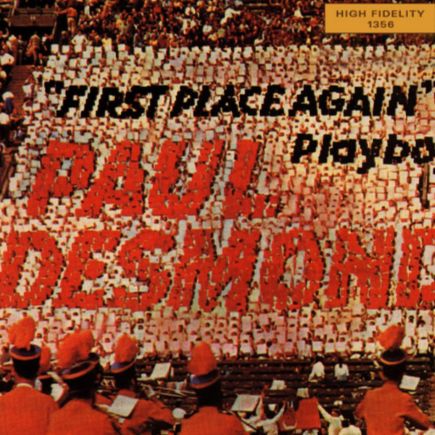Time After Time: un standard entre romance et réinvention jazz
Composée en 1947 par Jule Styne, sur des paroles de Sammy Cahn, Time After Time naît dans le film It Happened in Brooklyn (Tout le monde chante) interprété par Frank Sinatra avec une élégance douce et émotive. Dans la lignée des grandes ballades de l’ère pré-bop, cette chanson mêle romantisme assumé et raffinement harmonique.
Musicalement, le morceau repose sur une grille harmonique classique mais subtile, propice aux réharmonisations et à l’improvisation. La mélodie, à la fois fluide et délicatement sinueuse, permet à l’interprète de jouer avec les silences, les inflexions et les respirations, donnant au thème une profondeur émotionnelle toujours renouvelée.
Time After Time incarne l’art du standard: une chanson populaire magnifiée par les musiciens, renouvelée et enrichie par chaque interprétation, révélant l’intime dans l’universel.
Paul Desmond, la grâce en apesanteur
Enregistrée à New York du 5 au 7 septembre 1959 pour l’album First Place Again, cette version de Time After Time révèle l’art de Paul Desmond dans ce qu’il a de plus pur: une élégance naturelle, un sens aigu de la nuance et un refus délibéré de l’esbroufe. Accompagné par Jim Hall à la guitare, Percy Heath à la contrebasse et Connie Kay à la batterie — tous membres ou proches du Modern Jazz Quartet — Desmond s’inscrit ici dans une esthétique de l’intimité et de l’équilibre. Le titre de cet album du saxophoniste alto Paul Desmond fait référence au fait qu’il s’est à nouveau classé premier dans le sondage Downbeat.
Le son du saxophone alto, feutré et limpide, trace une ligne claire sans jamais forcer le trait. Chaque note semble respirer, pesée, offerte sans urgence. Cette sobriété expressive, signature de Desmond, tranche avec les exubérances alors fréquentes dans le jazz d’après-guerre, marqué par le hard bop ou les premiers éclats du free.
Jim Hall, partenaire de choix, adopte une posture tout aussi retenue. Ses harmonies aériennes et ses contrechants discrets créent un dialogue complice avec Desmond, fondé sur l’écoute et la respiration commune. Le soutien de Heath et Kay est d’une grande finesse: la contrebasse ancre l’ensemble avec souplesse, tandis que la batterie esquisse les contours rythmiques avec une extrême délicatesse. Dans ce contexte, Time After Time, à travers ce quartet sans piano, affirme avec Desmond une vision du jazz où le silence, la mélodie et la suggestion prennent le pas sur la virtuosité.
Time After Time: un estándar entre el romance y la reinvención jazzística
Compuesta en 1947 por Jule Styne, con letra de Sammy Cahn, Time After Time nació en la película It Happened in Brooklyn (Todo el mundo canta), interpretada por Frank Sinatra con una elegancia suave y emotiva. En la tradición de las grandes baladas de la era pre-bop, esta canción combina un romanticismo asumido con un refinamiento armónico sutil.
Musicalmente, la pieza se apoya en una estructura armónica clásica pero matizada, propicia para las reharmonizaciones y la improvisación. La melodía, fluida y delicadamente sinuosa, permite al intérprete jugar con los silencios, las inflexiones y las respiraciones, aportando al tema una profundidad emocional en constante renovación.
Time After Time encarna el arte del estándar: una canción popular sublimada por los músicos, renovada y enriquecida con cada interpretación, que revela lo íntimo en lo universal.
Paul Desmond, la gracia en suspensión
Grabada en Nueva York entre el 5 y el 7 de septiembre de 1959 para el álbum First Place Again, esta versión de Time After Time revela el arte de Paul Desmond en su forma más pura: una elegancia natural, un agudo sentido de la sutileza y una negativa deliberada al exceso. Acompañado por Jim Hall en la guitarra, Percy Heath en el contrabajo y Connie Kay en la batería — todos miembros o cercanos al Modern Jazz Quartet — Desmond se inscribe aquí en una estética de la intimidad y del equilibrio. El título del álbum alude al hecho de que Desmond volvió a ocupar el primer lugar en la encuesta de DownBeat.
El sonido de su saxofón alto, aterciopelado y cristalino, traza una línea clara sin necesidad de subrayar. Cada nota parece respirar, medida, ofrecida sin prisa. Esta sobriedad expresiva, propia de Desmond, contrasta con las exuberancias frecuentes en el jazz de la posguerra, dominado por el hard bop y los primeros signos del free jazz.
Jim Hall, compañero ideal, adopta una actitud igualmente contenida. Sus armonías aéreas y sus contracantos discretos establecen un diálogo íntimo con Desmond, fundado en la escucha mutua y la respiración compartida. El acompañamiento de Heath y Kay es de gran sutileza: el contrabajo sostiene con flexibilidad, mientras que la batería esboza contornos rítmicos con extrema delicadeza.
En este contexto, Time After Time, en la forma de un cuarteto sin piano, encarna junto a Desmond una visión del jazz en la que el silencio, la melodía y la sugerencia prevalecen sobre la pura demostración técnica.
Time After Time: uno standard tra romanticismo e reinvenzione jazz
Composta nel 1947 da Jule Styne, con testo di Sammy Cahn, Time After Time nasce nel film It Happened in Brooklyn (Tutti cantano), interpretata da Frank Sinatra con un’eleganza dolce e carica di emozione. Sulla scia delle grandi ballate dell’epoca pre-bop, questa canzone unisce romanticismo dichiarato e raffinatezza armonica.
Musicalmente, il brano si fonda su una struttura armonica classica ma sottile, ideale per reharmonizzazioni e improvvisazioni. La melodia, fluida e delicatamente sinuosa, consente all’interprete di giocare con i silenzi, le inflessioni e i respiri, offrendo al tema una profondità emotiva sempre rinnovata.
Time After Time incarna l’arte dello standard: un brano popolare sublimato dai musicisti, rinnovato e arricchito ad ogni interpretazione, che svela l’intimo nell’universale.
Paul Desmond, la grazia in sospensione
Registrata a New York dal 5 al 7 settembre 1959 per l’album First Place Again, questa versione di Time After Time rivela l’arte di Paul Desmond nella sua forma più essenziale: un’eleganza naturale, un senso acuto della sfumatura e un rifiuto deliberato dell’ostentazione. Accompagnato da Jim Hall alla chitarra, Percy Heath al contrabbasso e Connie Kay alla batteria — tutti membri o affini al Modern Jazz Quartet — Desmond si muove qui in un’estetica dell’intimità e dell’equilibrio. Il titolo dell’album fa riferimento al fatto che Desmond era tornato al primo posto nel sondaggio della rivista DownBeat.
Il suono del suo sax alto, vellutato e limpido, traccia una linea chiara senza mai forzare. Ogni nota sembra respirare, ponderata, offerta con calma. Questa sobrietà espressiva, firma inconfondibile di Desmond, contrasta nettamente con le esuberanze diffuse nel jazz del dopoguerra, dominato dall’hard bop e dai primi accenti del free jazz.
Jim Hall, partner ideale, adotta una postura altrettanto misurata. Le sue armonie ariose e i controcanti discreti creano un dialogo complice con Desmond, fondato sull’ascolto reciproco e una respirazione comune. Il sostegno di Heath e Kay è di grande finezza: il contrabbasso ancora l’ensemble con morbidezza, mentre la batteria delinea con estrema delicatezza i contorni ritmici.
In questo contesto, Time After Time, in un quartetto senza pianoforte, afferma con Desmond una visione del jazz in cui silenzio, melodia e suggestione prevalgono sulla pura virtuosità.
Time After Time: a standard between romance and jazz reinterpretation
Composed in 1947 by Jule Styne with lyrics by Sammy Cahn, Time After Time emerged in the film It Happened in Brooklyn, performed by Frank Sinatra with gentle, emotional elegance. In the tradition of the great pre-bop ballads, this song blends open romanticism with harmonic refinement.
Musically, the piece rests on a classic yet subtle harmonic structure, ideal for reharmonization and improvisation. The melody—both fluid and delicately winding—allows performers to play with silence, inflection, and breath, lending the theme a continually renewed emotional depth.
Time After Time embodies the art of the standard: a popular song elevated by musicians, renewed and enriched with each interpretation, revealing intimacy within universality.
Paul Desmond: grace in suspension
Recorded in New York from September 5 to 7, 1959, for the album First Place Again, this version of Time After Time showcases Paul Desmond’s artistry at its purest: natural elegance, a refined sense of nuance, and a deliberate avoidance of flashiness. Joined by Jim Hall on guitar, Percy Heath on bass, and Connie Kay on drums — all members or close associates of the Modern Jazz Quartet — Desmond embraces here a deeply intimate and balanced aesthetic. The album’s title refers to Desmond once again ranking first in the DownBeat readers’ poll.
His alto saxophone sound, velvety and clear, traces a line of quiet clarity without ever pressing too hard. Each note breathes, measured and unhurried. This expressive restraint, a hallmark of Desmond’s style, stands in stark contrast to the exuberance common in postwar jazz, dominated by hard bop and the early stirrings of free jazz.
Jim Hall, the perfect counterpart, adopts an equally restrained approach. His airy harmonies and subtle counterlines weave a delicate dialogue with Desmond, based on deep listening and shared breath. Heath and Kay provide a support of remarkable finesse: the bass anchors with supple ease, while the drums sketch rhythmic contours with exceptional delicacy.
Within this piano-less quartet, Time After Time becomes a statement — a vision of jazz where silence, melody, and suggestion take precedence over technical display.


